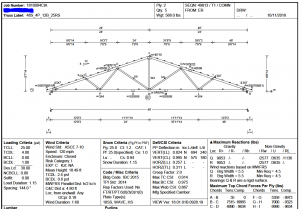Things Roof Truss Manufacturers SHOULD Ask, But Don’t Always
I didn’t just fall off of a turnip truck yesterday, even though there are a few who may doubt my claim!
Prefabricated metal plate connected wood trusses and I became close friends back in April of 1977. Yes, we had electricity then and no, I did not watch space aliens build Egypt’s pyramids. Eventually I owned and operated two truss plants for 17 years. I know it may sound odd, but I did learn a couple of things.
Most of us do not know to ask (or tell) what we are not asked. When Hansen Pole Buildings’ Wizardress of Ordering Justine gives information to our trusted truss suppliers, all of these factors below have been incorporated into our order. This insures your trusses will be adequate to handle loads being placed upon them.
Chances are you (as well as most other post frame building kit suppliers and/or contractors) have not taken all of these into account. In failing to do so, your building may not do everything you want it to do not only today, but also years from now (or could even fall down and go boom).
Here we go:
Span from outside of wall to outside of wall. Eave overhangs are not considered as part of a span.
Desired slope(s) – with scissor trusses to achieve a vaulted ceiling or added center headroom, provide an interior or exterior ‘must have’ and other slope will be determined from ‘must have’ slope.
Spacing (ideally you will be using double trusses spaced directly on columns) rather than going into some lengthy dissertation on truss spacing, please read this article: https://www.hansenpolebuildings.com/2011/06/pole-barn-truss-spacing/.
 Overhangs on eave sides (measured parallel to ground), as well as beyond endwalls. Why is beyond endwalls important? For sake of discussion assume single trusses placed every two feet, unless specified and designed otherwise and end truss in this scenario can only support a foot of overhang past an end. Single trusses placed every four feet can support a maximum two foot end overhang.
Overhangs on eave sides (measured parallel to ground), as well as beyond endwalls. Why is beyond endwalls important? For sake of discussion assume single trusses placed every two feet, unless specified and designed otherwise and end truss in this scenario can only support a foot of overhang past an end. Single trusses placed every four feet can support a maximum two foot end overhang.
Roofing material and any solar or rooftop arrays. How many psf (pounds per square foot) must your trusses support? Steel roofing is fairly light weight. If using shingles, Code requires incorporation of enough load capacity for a reroofing down the road.
Is roofing over purlins, sheathing? Maybe sheathing AND purlins. Whichever is your case, these weights need to be accounted for as top chord dead loads.
Ceiling? If not now, ever? One of my most asked questions is in regards to adding ceilings in existing post frame buildings. At a bare minimum to support steel liner panels bottom chord dead load should be three psf, for gypsum wallboard (sheetrock) five psf. Last year Hansen Pole Buildings opted to increase bottom chord dead load for all trusses spanning 40 feet or less to five psf. We do not frankly do a very good job of promoting the benefits of this feature.
If attic is insulated, weight of ceiling material, ceiling joists and attic floor insulation.
Design wind speed and exposure. More buildings fail from roofs blowing off, than from snow. Depending upon Code year and version, wind speed may be expressed as Vult or Vasd. There is a difference and whoever is going to build trusses needs to know. If you do not fully understand differences between B and C wind exposure, learn quick: https://www.hansenpolebuildings.com/2012/03/wind-exposure-confusion/
Heated or Unheated? There is a factor relating to whether your building will be heated and it influences design snow load. Heated buildings help melt snow off.
Overall building dimensions: width, length, height above grade. These factors impact wind design.
Risk Category – How your building will be used impacts design snow and wind loads. Buildings with infrequent human occupancy have less risk and can be designed for a greater probability of failure in event of an extreme weather event.
Energy heels for full depth attic insulation? If ever insulation might be blown into a dead attic space for purposes of climate control, to be effective it should be full depth from outside of wall to outside of wall. For extended reading: https://www.hansenpolebuildings.com/2012/07/raised-heel-trusses/
Siding material (so proper gable truss recommendations can be made). If supporting other than roll formed steel siding, end truss probably will require vertical studs. Without a continuous wall beneath an end truss, it must be ordered as a structural gable.
Is the building fully enclosed, partially enclosed or open? This will again influence wind design.
Are you interested in parallel chords with a heel height to create a vaulted ceiling? You can get the same slope inside and out with this method.
Done right you would be offered options to increase load carrying capacities against either wind, snow or both. This is true value added design. Builders most always want bare minimums, while people who are doing DIY homes or barndominiums are most likely to increase capacities. If in doubt – own the last building standing!
When I was building trusses I had extremely high expectations of my truss staff, we always wanted to offer designs to exceed our client’s expectations.
Too many factors to juggle? You do not have to fret with an engineered Hansen Pole Building. Please call 1(866)200-9657 today.
P.S. Remember, I have no current interest in any truss manufacturing facility so please don’t contact me for truss prices, thanks.






